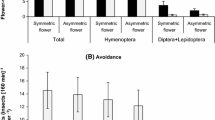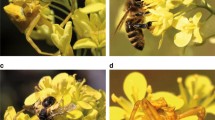Summary
Predators on flower visitors, such as spiders, could influence plant reproduction by determining the balance between pollination and seed predation by insects. This study examines the net effect of predation by the inflorescence spider, Peucetia viridans (Hentz), for seed production by a native plant species on which it hunts. Both pollination and seed set of Haplopappus venetus (Asteraceae) were reduced on branches with spiders; however, the release of viable, undamaged seed was higher on inflorescence branches with spiders than on those without. Occurrence of P. viridans was associated with the flat-topped inflorescence branch structure characteristic of H. venetus rather than with the vertical structure of its congener, H. squarrosus. Thus, the interaction should be a reinforcing selective pressure on inflorescence branch morphology of H. venetus over time. Two factors providing constraints on the degree and rate of coevolution of the plant-spider interaction are suggested by the results: (1) the critical role of phenological synchrony and (2) the opposing requirements of interacting species and of subsequent life history stages within a species.
Similar content being viewed by others
References
Baker HG, Hurd PD Jr (1968) Intrafloral ecology. Ann Rev Entomol 13:385–414
Bentley BL (1976) Plants bearing extrafloral nectaries and the associated ant community: interhabitat differences in the reduction of herbivore damage. Ecology 57:815–820
Bentley BL (1977) Extrafloral nectaries and protection by pugnacious bodyguards. Ann Rev Ecol Syst 8:407–427
Bohart GE, Koerber TW (1972) Insects and seed production. Pp. 1–50 in TT Kozlowski (ed), Seed Biology, Vol 3. Academic Press, New York
Brady AR (1964) The lynx spiders of North America north of Mexico (Araneae: Oxyopidae). Bull Mus Comp Zool Harvard Univ 131(13):429–518
Buss LW, Jackson JBC (1979) Competitive networks: nontransitive competitive relationships in cryptic coral reef environments. Amer Nat 113:223–234
Carroll CR, Janzen DH (1973) Ecology of foraging by ants. Ann Rev Ecol Syst 4:231–258
Cates RG, Orians GH, Rhoades DF, Schultz JC, Tomoff CS (1977) Resource utilization systems: the plant-foliage eater-predator system. In: GH Orians, OT Solbrig (eds) Convergent evolution in warm deserts, pp 166–196. Dowden, Hutchinson, and Ross, Stroudsburg, PA
Comstock JH (1940) The spider book. Doubleday, Doran and Company, New York
Doris PR (1970) Spiders collected from mud dauber nests in Mississippi. J Kansas Ent Soc 43:10–11
Faegri K, van der Pijl L (1971) The principles of pollination ecology (Second ed). Pergamon Press, Oxford
Gertsch WJ (1979) American spiders. Van Nostrand, Reinhold Pub, New York
Givens RP (1978) Dimorphic foraging strategies of a salticid spider (Phidippus audax). Ecology 59:309–321
Greenstone MH (1978) The numerical response to prey availability of Pardosa ramulosa (McCook) (Araneae: Lycosidae) and its relationship to the role of spiders in the balance of nature. Symp Zool Soc Lond 42:183–193
Hallander H (1967) Range and movements of the wolf spiders Pardosa chelata (OF Muller) and P. pullata (Clerck). Oikos 18:360–364
Hallander H (1970) Prey, cannibalism and microhabitat selection in the wolf spiders Pardosa chelata (OF Muller) and P. pullata (Clerck). Oikos 21:337–340
Harper JL (1977) The population biology of plants. Academic Press, New York
Harris P (1973) Insects in the population dynamics of plants. In: HF van Emden (ed) Insect/plant relationships, pp 201–210. Blackwell, Oxford
Haynes DL, Sisojevic P (1966) Predatory behavior of Philodromus rufus (Araneae: Thomisidae). Can Entomol 98:113–133
Inouye D, Taylor OR (1979) A temperate region plant-ant-seed predator system: consequences of extrafloral nectar secretion by Helianthella guinquenervis. Ecology 60:1–7
Jackson MT (1966) Effects of microclimate on spring flowering phenology. Ecology 47:407–415
Janzen DH (1966) Coevolution of mutualism between ants and acadias in Central America. Evolution 20:249–275
Janzen DH (1967) Fire, vegetation structure, and the ant x acacia interaction in Central America. Ecology 48:26–35
Janzen DH (1971) Seed predation by animals. Ann Rev Ecol Syst 2:465–492
Janzen DH (1980) When is it coevolution? Evolution 34:611–612
Kessler A (1971) Relation between egg production and food consumption in species of the genus Pardosa (Lycosidae, Araneae) under experimental conditions of food abundance and food shortage. Oecologia (Berl) 8:93–109
Kurczewski FE, Kurczewski EJ (1968) Host records for some North American Pompilidae (Hymenoptera) with discussion of factors in prey selection. J Kansas Entomol Soc 41:1–33
Lamb WO (1980) Predispersal seed predation of the Platte thistle and its effect on seed production. PhD thesis, Univ of Nebraska, 173 pp
Louda SM (1978) A test of predispersal seed predation in the population dynamics of Haplopappus (Asteraceae). PhD thesis, Univ of California, Riverside and San Diego State University, 185 pp
Louda SM (1982a) Limitation of the recruitment of the shrub Haplopappus squarrosus (Asteraceae) by flower- and seed-feeding insects. J Ecol 70(1):43–53
Louda SM (1982b) Distribution ecology: variation in plant recruitment over a gradient in relation to insect seed predation. Ecol Monogr 52(1):25–41
Louda SM (1983) Seed predation and seedling mortality in the recruitment of a shrub, Haplopappus ventus Blake (Asteraceae), along a climatic gradient. Ecology: in press
Lowrie DC (1963) Effects of grazing and intensive collecting on a population of the green lynx spider. Ecology 44:777–781
Marden L (1963) The man who talks to hummingbirds. Nat Geographic Mag 123:80–99
McKaye KR (1977) Defense of a predator's young by an herbivorous fish: an unusual strategy. Amer Nat 111:301–315
McKaye KR (1979) Defense of a predator's young revisited. Amer Nat 114:595–601
Messina FJ (1981) Plant protection as a consequence of an antmembracid mutualism: interactions on goldenrod (Solidago sp). Ecology 62:1433–1440
Mooney HA (1977) Southern coastal scrub. In: M Barbour and J Major (eds), Terrestrial vegetation of California pp 471–489. Wiley Interscience, New York
Morse DH (1979) Prey capture by the crab spider Misumena calycina (Araneae: Thomisidae). Oecologia (Berl) 39:309–319
Morse DH (1980) Interactions among syrphid flies and bumblebees on flowers. Ecology 62:81–88
Muma MH, Jeffers WF (1945) Studies of the spider prey of several mud-dauber wasps. Ann Ent Soc Amer 38:245–255
Munz P, Keck DD (1959) A California flora. University of California Press, Berkeley
Olive CW (1980) Foraging specializations in orb-weaving spiders. Ecology 61:1133–1144
Pleasants JM (1980) Competition for bumblebee pollinators in Rocky Mountain plant communities. Ecology 61:1446–1459
Price PW, Bouton CE, Gross P, McPheron BA, Thompson JN, Weis AE (1980) Interactions among three trophic levels: influence of plants on interactions between insect herbivores and natural enemies. Ann Rev Ecol Syst 11:41–66
Pyke GH, Pulliam HR, Charnov EL (1977) Optimal foraging: a selective review of theory and tests. Q Rev Biol 52:137–154
Richards AJ (1978) The pollination of flowers by insects. Academic Press, New York
Riechert SE, Tracy CR (1975) Thermal balance and prey availability: basis for a model relating web-site characteristics to spider reproductive success. Ecology 56:265–284
Roughgarden J (1976) Resource partitioning among competing species — a coevolutionary approach. Theor Pop Biol 9:388–424
Salisbury EJ (1942) The reproductive capacity of plants. Bell Ltd, London
Skinner GJ, Whittaker JB (1981) An experimental investigation of inter-relationships between the wood-ant (Formica rufa) and some tree-canopy herbivores. J Anim Ecol 50:313–326
Sørenson T (1941) Temperature relations and phenology of the northeast Greenland flowering plants. Medd Grønland 125:1–305
Tilman D (1978) Cherries, ants and tent caterpillars: timing of nectar production in relation to susceptibility of caterpillars to ant predation. Ecology 59:686–692
Turnbull AL (1965) Effects of prey abundance on the development of the spider Agelenopsis potteri (Blackwell) (Araneae: Agelenidae). Can Entomol 97:141–147
Turnbull AL (1972) Ecology of the true spiders (Araneomorphae). Ann Rev Entomol 18:305–348
Waser NM (1978) Competition for hummingbird pollination and sequential flowering in two Colorado wildflowers. Ecology 59:934–944
Whitcomb WH, Hite M, Eason R (1966) Life history of the green lynx spider, Peucetia viridans (Araneida: Oxyopidae). J Kansas Entomol Soc 39:259–267
Whittaker JB (1979) Invertebrate grazing, competition and plant dynamics. In: RM Anderson, BD Turner, LR Taylor (eds) Population dynamics, pp 207–222. Blackwell, Oxford
Wise DH (1975) Food limitation of the spider Linyphia marginata: experimental field studies. Ecology 56:637–646
Wise DH (1979) Effects of an experimental increase in prey abundance upon the reproductive rates of two orb-weaving spider species (Araneae: Araneidae). Oecologia (Berl) 41:289–300
Zimmerman M (1980a) Reproduction in Polemonium: competition for pollinators. Ecology 61:497–501
Zimmerman M (1980b) Reproduction in Polemonium: pre-dispersal seed predation. Ecology 61:502–506
Author information
Authors and Affiliations
Rights and permissions
About this article
Cite this article
Louda, S.M. Inflorescence spiders: A cost/benefit analysis for the host plant, Haplopappus venetus Blake (Asteraceae). Oecologia 55, 185–191 (1982). https://doi.org/10.1007/BF00384486
Received:
Issue Date:
DOI: https://doi.org/10.1007/BF00384486




